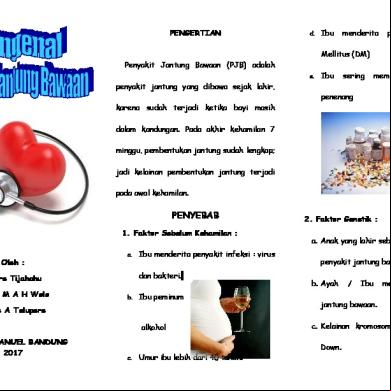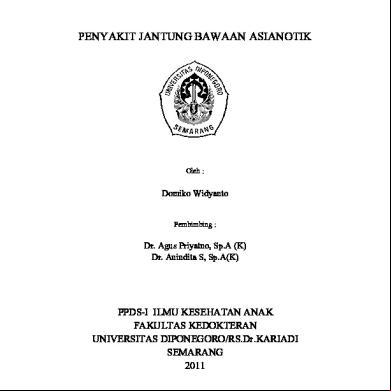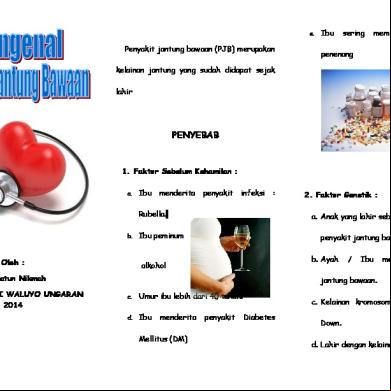Pjb 2018 5a2f4t
This document was ed by and they confirmed that they have the permission to share it. If you are author or own the copyright of this book, please report to us by using this report form. Report 2z6p3t
Overview 5o1f4z
& View Pjb 2018 as PDF for free.
More details 6z3438
- Words: 1,254
- Pages: 67
Structures of the heart
Normal Heart
KLASIFIKASI • PJB ASIANOTIK – ASD – VSD – PDA
- AVSD - PS
• PJB SIANOTIK – TOF – TGA – TAPVD
- TRIKUSPID ATRESIA - TRUNKUS ARTERIOSUS - ATRESIA PULMONAL
Atrial Septal defect ( ASD ) • Insidence : + 10 % • : ratio = 1,5 to 2 : 1 • Anatomy : Defect on foramen ovale : Secundum ASD Defect at SVC and RA junction: sinus venosus ASD Defect at ostium primum : primum ASD
ANATOMY
ASD
Atrial Septal Defect
Diagram of ASD
Clinical Features Symptoms Most infants : asymptomatic …..undetected The first present at age 6 to 8 weeks with a soft murmur and possibly a fixed and somewhat widely split S2 Infant with large ASD may present with poor growth, recurrent lower respiratory tract infection and heart failure
Atrial septal defect
Lungs
LV
LA
AO
PA
Systemic RV
RA
Qp > Qs
Atrial septal Defect
RA
RV
RA
LA
RV
LV
LA
LV
Atrial Septal Defect
Auscultation :1st HS N or loud widely split and fixed 2nd HS Ejection Sistolic Murmur
Atrial Septal Defect
Diagnosis Differential Primary Atrial Septal Defect ECG : LAD Partial Anomalous Pulmonary Vein Drainage Pulmonary Stenosis Innocent Murmur
Atrial Septal defect
Management Surgery : Preschool age Recent treatment: transcatheter closure using ASO (Amplatzer septal occluder)
ASD Large Shunt
Small Shunt Infants
Children/Adults
Observation Evaluation At age 5-8 yrs Cath
FR<1.5
PH (-) Heart Failure (+) PVD (-) Anti failure
Success
FR>1.5
Conservative
Heart Failure (-)
Age >1yrs W >10kg
PH (+) PVD (+) Hyperoxia
Fail
Surgical Closure
Reactive
Transcatheter closure (Secundum ASD) / Surgical Closure(other tipe of ASD)
Non reactive
Conservative
Transchateter closure of ASD
Atrial septal defect
Ventricular septal defect • Insidence 20 % of all CHD No sex influenced • Anatomy Subarterial defect : below pulmonary and aortic valve Perimembranous defect: below aortic valve at pars membranous septum Muscular defect
VSD
Ventricular Septal defect
Lungs
LV
LA
AO
PA
RA
RV
Qp > Qs
Systemic
Ventricular septal defect
RA
RV
LA
LV
RA
LA
RV
LV
Ventricular Septal Defect
• Clinical findings Day 1st after birth: murmur (-) After 2-6 weeks : murmur (+) Murmur : pansystolic grade 3/6 or higher at LSB 3 Small muscular defect: early systolic murmur Significant defect: Mid diastolic murmur at apex
Ventricular Septal Defect
Murmur: pansystolic grade 3/6 or higher at LSB 3
Small VSD
Large VSD
Ventricular Septal Defect
Cardiomegaly Apex down ward Prominence pulmonary artery segment Increased pulmonary vascular marking
Ventricular septal Defect
Diagnosis Differential
PDA with PH Tetralogy Fallot non cyanotic Inoscent murmur
Ventricular septal defect
Management: Definitive : VSD closure Surgery Transcatheter closure
DSV Heart failure (+)
Heart failure (-)
Anti failure
Aortic valve prolaps Fail
Infundibular stenosis
PVD(-)
Success PAB Evaluate in 6 mths
PH Spontaneous closure
Cath
PVD(+)
Cath Reactive
Smaller
Cath
FR<1.5 FR>1.5
Nonreactive Conservative
Surgical closure/Transcatheter closure
Patent Ductus Arteriosus Anatomy Fetus: ductus arteriosus connects PA and aorta If ductus does not closs Patent Ductus arteriosus
PDA
Patent Ductus Arteriosus
RA
RV
LA
LV
RA
LA
RV
LV
Patent Ductus Arteriosus
Lungs
LV
LA
AO
PA
Systemic RA
RV
Qp > Qs
• PDA is more common in : Premature infants
■ BW < 1750 g : 45% ■ BW < 1200 g : 80% Genetic abnormalities Infants whose mother had German measles (Rubella)
• PDA in preterm haemodynamic instability co-morbidity & mortality EARLY DIAGNOSIS
Patent Ductus Arteriosus
• Clinical findings Small defect: Symptom (-) Growth and development normal Moderate and large defect: Decreased exercise tolerant Weigh gained not good Frequent URTI
DIAGNOSIS • Medical history : asphyxia,preterm,congenital rubella, chromosomal aberrations
• Physical examination : bounding pulse, wide blood pressure, hyperactive precordium, present of murmur ed by CXR, ECG Confirmed by Echocardiography
Patent Ductus Arteriosus
Auscultation : continuosus murmur at upper LSB 2
Chest X-Ray
Large PDA: Prominence of the left atrium, left ventricle, ascending aorta, Pulmonary vascular marking
ECG • • • •
Small PDA : normal Moderate PDA : LVH Large PDA : BVH PDA with PVOD : RVH
Patent Ductus Arteriosus
Diagnosis Differential AP-window Arterio-venous fistulae Management premature: ibuprofen PDA closure : surgery transcatheter closure
MANAGEMENT • Medical treatment : prostaglandin synthesis inhibitor Preterm neonates : usefull Aterm neonates : useless
• Transcatheter closure : mostly choice treatment • Surgical closure : Infant < 5 kg with large PDA Preterm neonates : medical treatment unsuccessful or contraindicated
PDA IN PRETERM NEONATES • Special problem : haemodynamic instability • Treatment should be started as soon as PDA suspected Once a significant shunt is present increased pulmonary blood flow damage to premature lungs
• PDA can be closed with prostaglandin synthesis inhibitors
TRANSCATHETER CLOSURE
*Transcatheter occlusion is effective with a high rate of complete occlusion *Complication rare
Tetralogy Fallot Incidence 5-8% from all CHD Anatomy Cause: Left-anterior deviation of infundibular septum Sindroma consist of 4 items: VSD pulmonary stenosis aortic over-riding RVH
Tetralogy Fallot
Central cyanosis
Central cyanosis
Pathophysiology • Cyanosis is a bluish discoloration of the skin and mucous membranes resulting from an increased concentration of reduced hemoglobin • Clinical cyanosis occurs when the amount of reduced hemoglobin in the cutaneous vein may result 5 g/100ml • The critical level of reduced hemoglobin in the cutaneous vein may result from either desaturation of arterial blood or increased extraction of oxygen by peripheral tissue
Cardiac causes of cyanosis • Inadequate pulmonary blood flow (severe cyanosis) – Tricuspid atresia – Pulmonary atresia – Tetralogy of Fallot
• Independent pulmonary and systemic circulation (severe cyanosis) – Tranpose great artery
• Mixing (moderate cyanosis) – Truncus arteriosus
Diagnosis Clinically : cyanosis Single 2nd HS, ejection systolic murmur
X Ray : Boot Shaped ECG: RAD, RVH
Tetralogy Fallot
Single 2nd HS, ejection systolic murmur
CXR : Boot-shaped Concave pulmonary segment Apex upturned Decreased pulmonary blood flow
Tetralogy Fallot
ECG : RAD, RVH Echocardiography : to confirm diagnosis
Tetralogy Fallot
• Diagnosis Differential Pulmonary Atresia Double outlet right ventricle and pulmonary stenosis Transposisi of great arteri and pulmonary stenosis
Management Paliative treatment: Blalock-Taussig shunt Definitive: total correction
• clinically • ECG
Tetralogy of Fallot
< 1 yr
• CXR • echo
> 1 yr
spell (+) propranolol
spell (-) age 1 yr
failed
cath
succeed
BTS evaluation
cath
BTS/ PDA Stent
small PA
total correction
good sized PA
Transposition of Great Artery Insidence 5% of CHD Anatomy Abnormality of formation of trunkal septum that cause aorta arising from RV and PA arising from LV
Transposition of Great artery
Transposition of Great artery
Hemodynamic normal “series”
Hemodynamic of TGA “parallel”
Transposition of Great artery
• Clinical aspects More frequent in male Birth weight usually normal normal or bigger Cyanotic vary from mild to severe Auscultation : single 2nd HS and loud Murmur vary from silent to pansystolic murmur or continuous murmur
Transposition of Great artery
• Diagnosis Clinically : Suspicious if neonates presents with cyanotic with birth weight normal or bigger Murmur (-) Single 2nd HS and loud
Transposition of Great artery
Murmur (-) Single 2nd HS and loud
Transposition of Great artery
ECG : RAD RVH Echocardiography : to confirm diagnosis Cardiac catheterization: usually is not needed
Transposition of Great artery
Diagnosis Differential trunkus arteriosus trikuspid atresia pulmonary atresia Management
Surgery: arterial switch Paliative : Blalock-Taussig shunt
Transposition of Great artery
TERIMA KASIH
Normal Heart
KLASIFIKASI • PJB ASIANOTIK – ASD – VSD – PDA
- AVSD - PS
• PJB SIANOTIK – TOF – TGA – TAPVD
- TRIKUSPID ATRESIA - TRUNKUS ARTERIOSUS - ATRESIA PULMONAL
Atrial Septal defect ( ASD ) • Insidence : + 10 % • : ratio = 1,5 to 2 : 1 • Anatomy : Defect on foramen ovale : Secundum ASD Defect at SVC and RA junction: sinus venosus ASD Defect at ostium primum : primum ASD
ANATOMY
ASD
Atrial Septal Defect
Diagram of ASD
Clinical Features Symptoms Most infants : asymptomatic …..undetected The first present at age 6 to 8 weeks with a soft murmur and possibly a fixed and somewhat widely split S2 Infant with large ASD may present with poor growth, recurrent lower respiratory tract infection and heart failure
Atrial septal defect
Lungs
LV
LA
AO
PA
Systemic RV
RA
Qp > Qs
Atrial septal Defect
RA
RV
RA
LA
RV
LV
LA
LV
Atrial Septal Defect
Auscultation :1st HS N or loud widely split and fixed 2nd HS Ejection Sistolic Murmur
Atrial Septal Defect
Diagnosis Differential Primary Atrial Septal Defect ECG : LAD Partial Anomalous Pulmonary Vein Drainage Pulmonary Stenosis Innocent Murmur
Atrial Septal defect
Management Surgery : Preschool age Recent treatment: transcatheter closure using ASO (Amplatzer septal occluder)
ASD Large Shunt
Small Shunt Infants
Children/Adults
Observation Evaluation At age 5-8 yrs Cath
FR<1.5
PH (-) Heart Failure (+) PVD (-) Anti failure
Success
FR>1.5
Conservative
Heart Failure (-)
Age >1yrs W >10kg
PH (+) PVD (+) Hyperoxia
Fail
Surgical Closure
Reactive
Transcatheter closure (Secundum ASD) / Surgical Closure(other tipe of ASD)
Non reactive
Conservative
Transchateter closure of ASD
Atrial septal defect
Ventricular septal defect • Insidence 20 % of all CHD No sex influenced • Anatomy Subarterial defect : below pulmonary and aortic valve Perimembranous defect: below aortic valve at pars membranous septum Muscular defect
VSD
Ventricular Septal defect
Lungs
LV
LA
AO
PA
RA
RV
Qp > Qs
Systemic
Ventricular septal defect
RA
RV
LA
LV
RA
LA
RV
LV
Ventricular Septal Defect
• Clinical findings Day 1st after birth: murmur (-) After 2-6 weeks : murmur (+) Murmur : pansystolic grade 3/6 or higher at LSB 3 Small muscular defect: early systolic murmur Significant defect: Mid diastolic murmur at apex
Ventricular Septal Defect
Murmur: pansystolic grade 3/6 or higher at LSB 3
Small VSD
Large VSD
Ventricular Septal Defect
Cardiomegaly Apex down ward Prominence pulmonary artery segment Increased pulmonary vascular marking
Ventricular septal Defect
Diagnosis Differential
PDA with PH Tetralogy Fallot non cyanotic Inoscent murmur
Ventricular septal defect
Management: Definitive : VSD closure Surgery Transcatheter closure
DSV Heart failure (+)
Heart failure (-)
Anti failure
Aortic valve prolaps Fail
Infundibular stenosis
PVD(-)
Success PAB Evaluate in 6 mths
PH Spontaneous closure
Cath
PVD(+)
Cath Reactive
Smaller
Cath
FR<1.5 FR>1.5
Nonreactive Conservative
Surgical closure/Transcatheter closure
Patent Ductus Arteriosus Anatomy Fetus: ductus arteriosus connects PA and aorta If ductus does not closs Patent Ductus arteriosus
PDA
Patent Ductus Arteriosus
RA
RV
LA
LV
RA
LA
RV
LV
Patent Ductus Arteriosus
Lungs
LV
LA
AO
PA
Systemic RA
RV
Qp > Qs
• PDA is more common in : Premature infants
■ BW < 1750 g : 45% ■ BW < 1200 g : 80% Genetic abnormalities Infants whose mother had German measles (Rubella)
• PDA in preterm haemodynamic instability co-morbidity & mortality EARLY DIAGNOSIS
Patent Ductus Arteriosus
• Clinical findings Small defect: Symptom (-) Growth and development normal Moderate and large defect: Decreased exercise tolerant Weigh gained not good Frequent URTI
DIAGNOSIS • Medical history : asphyxia,preterm,congenital rubella, chromosomal aberrations
• Physical examination : bounding pulse, wide blood pressure, hyperactive precordium, present of murmur ed by CXR, ECG Confirmed by Echocardiography
Patent Ductus Arteriosus
Auscultation : continuosus murmur at upper LSB 2
Chest X-Ray
Large PDA: Prominence of the left atrium, left ventricle, ascending aorta, Pulmonary vascular marking
ECG • • • •
Small PDA : normal Moderate PDA : LVH Large PDA : BVH PDA with PVOD : RVH
Patent Ductus Arteriosus
Diagnosis Differential AP-window Arterio-venous fistulae Management premature: ibuprofen PDA closure : surgery transcatheter closure
MANAGEMENT • Medical treatment : prostaglandin synthesis inhibitor Preterm neonates : usefull Aterm neonates : useless
• Transcatheter closure : mostly choice treatment • Surgical closure : Infant < 5 kg with large PDA Preterm neonates : medical treatment unsuccessful or contraindicated
PDA IN PRETERM NEONATES • Special problem : haemodynamic instability • Treatment should be started as soon as PDA suspected Once a significant shunt is present increased pulmonary blood flow damage to premature lungs
• PDA can be closed with prostaglandin synthesis inhibitors
TRANSCATHETER CLOSURE
*Transcatheter occlusion is effective with a high rate of complete occlusion *Complication rare
Tetralogy Fallot Incidence 5-8% from all CHD Anatomy Cause: Left-anterior deviation of infundibular septum Sindroma consist of 4 items: VSD pulmonary stenosis aortic over-riding RVH
Tetralogy Fallot
Central cyanosis
Central cyanosis
Pathophysiology • Cyanosis is a bluish discoloration of the skin and mucous membranes resulting from an increased concentration of reduced hemoglobin • Clinical cyanosis occurs when the amount of reduced hemoglobin in the cutaneous vein may result 5 g/100ml • The critical level of reduced hemoglobin in the cutaneous vein may result from either desaturation of arterial blood or increased extraction of oxygen by peripheral tissue
Cardiac causes of cyanosis • Inadequate pulmonary blood flow (severe cyanosis) – Tricuspid atresia – Pulmonary atresia – Tetralogy of Fallot
• Independent pulmonary and systemic circulation (severe cyanosis) – Tranpose great artery
• Mixing (moderate cyanosis) – Truncus arteriosus
Diagnosis Clinically : cyanosis Single 2nd HS, ejection systolic murmur
X Ray : Boot Shaped ECG: RAD, RVH
Tetralogy Fallot
Single 2nd HS, ejection systolic murmur
CXR : Boot-shaped Concave pulmonary segment Apex upturned Decreased pulmonary blood flow
Tetralogy Fallot
ECG : RAD, RVH Echocardiography : to confirm diagnosis
Tetralogy Fallot
• Diagnosis Differential Pulmonary Atresia Double outlet right ventricle and pulmonary stenosis Transposisi of great arteri and pulmonary stenosis
Management Paliative treatment: Blalock-Taussig shunt Definitive: total correction
• clinically • ECG
Tetralogy of Fallot
< 1 yr
• CXR • echo
> 1 yr
spell (+) propranolol
spell (-) age 1 yr
failed
cath
succeed
BTS evaluation
cath
BTS/ PDA Stent
small PA
total correction
good sized PA
Transposition of Great Artery Insidence 5% of CHD Anatomy Abnormality of formation of trunkal septum that cause aorta arising from RV and PA arising from LV
Transposition of Great artery
Transposition of Great artery
Hemodynamic normal “series”
Hemodynamic of TGA “parallel”
Transposition of Great artery
• Clinical aspects More frequent in male Birth weight usually normal normal or bigger Cyanotic vary from mild to severe Auscultation : single 2nd HS and loud Murmur vary from silent to pansystolic murmur or continuous murmur
Transposition of Great artery
• Diagnosis Clinically : Suspicious if neonates presents with cyanotic with birth weight normal or bigger Murmur (-) Single 2nd HS and loud
Transposition of Great artery
Murmur (-) Single 2nd HS and loud
Transposition of Great artery
ECG : RAD RVH Echocardiography : to confirm diagnosis Cardiac catheterization: usually is not needed
Transposition of Great artery
Diagnosis Differential trunkus arteriosus trikuspid atresia pulmonary atresia Management
Surgery: arterial switch Paliative : Blalock-Taussig shunt
Transposition of Great artery
TERIMA KASIH










